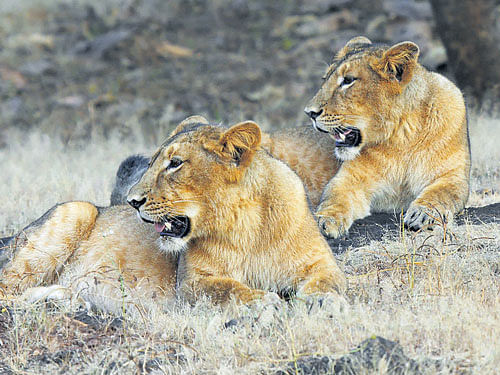
The sun was on the horizon. The sky had a light hue of the crimson. I had to start my 3-hour journey from Somnath Temple to the Gir forest at sunset. On the one hand, I did not want to miss the sunset on the beach, on the other, I had to reach my destination on time.
I was part of a group of travel writers invited by the Gujarat Tourism on a familiarisation trip. Tucked away deep into the lion safari camp of Gir forest was a cluster of tented accommodations by the Camps of India, where my stay was planned for the night.
Walking on the gravel road, occasionally making noises to keep reptiles at bay, I headed to my tent. The full moon was spilling light on the forest area. The camp manager had advised against stepping out at night, come what may. “There is a stream close by, but going there is prohibited as there are crocodiles,” he had cautioned. “Don’t worry, I will be walking around in the night. You can sleep peacefully,” came the comforting words from a caretaker.
The unfamiliar noises from the jungle had been a background score all night long. It was not the alarm that woke me up. What most of my fellow travellers termed as a “loud noise” had me out of slumber way before dawn. It was 5 am. I had to set out into the jungle before 6 am. Sipping some piping hot tea in the camp, an impromptu discussion kicked off about the “loud noise”. Even as I knew a better term to describe the sound, I was not sure if the guess would be right. “Yes, that was a lion’s roar. It must have been around the place last night,” said the guide, only to leave me with goosebumps.
A 10-minute drive was what it took to the Sasan Gir forest safari. I had packed light cotton clothes for the trip anticipating high temperatures in Gujarat. Little did I know that it would be biting cold in the morning. When I entered the Sasan Gir forest in an open jeep, there was a slight orange tint to the muddy trail at sunrise.
The spotted deer and sambar were the first animals I could spot on entering the forest. Busy having their morning meal, these animals looked up only occasionally. By now, peacocks did not hold any surprises. They were plenty in number. The safari driver said that if I was fortunate, I would also be able to spot cheetahs or leopards. Unfortunately, I did not.
It had been an hour since I entered the Sasan Gir Forest, and had not spotted even one Asiatic lion yet. “Every time I take this path, I spot at least one. If luck is on your side, even you might,” said the driver, oozing optimism.
In all the excitement, I had failed to note that travelling through the mud path had left a thick layer of dust on my face and clothes. The streams and ponds, that I happened to pass on my way, barely had any water. These were the most common places to spot the lion, I was told. Dave, the forest official who had accompanied me, said they had also built large tanks to supplement the animals’ water needs during summer.
The jeep that was ahead of mine stopped at a junction. Everyone was curiously peeping out in one direction. The guide pointed at the surface. “Pugmarks!” someone shouted. They were about the size of human fists. Before I could react, the driver told me that they were pugmarks of an Asiatic lion, but not an adult one. “That is almost as big as a human palm,” he remarked.
I had grown more optimistic by then. Scattered skulls of cattle and bones dotted the sides of the road. For locals, it was a common sight. It was astonishing to see the fearlessness with which the trackers and forest officials travelled alone inside the forest.
Two jeeps were parked in a corner. It was the most awaited moment. Two Asiatic lions stood at a distance of about 20 feet. Giant and majestic. I fell short of words to describe how handsome they looked.
“It is rare to spot two male lions in the same place. They usually don’t like entering each other’s territory,” Dave said. Trackers were at a close distance. While I stayed there for about 15 minutes, the lions appeared least interested in all the drama. They sat with their backs toward me. I had seen the majestic animal caged in zoos and tamed in circuses as a child. However, to see the royal Asiatic lion, in its original habitat, is a different experience altogether. A fully-grown lion, the safari driver told us, would measure at least 7 feet in length. This one, I estimated was close to the same.
As the two lions headed back into the forest, I was left with the experience of a lifetime.